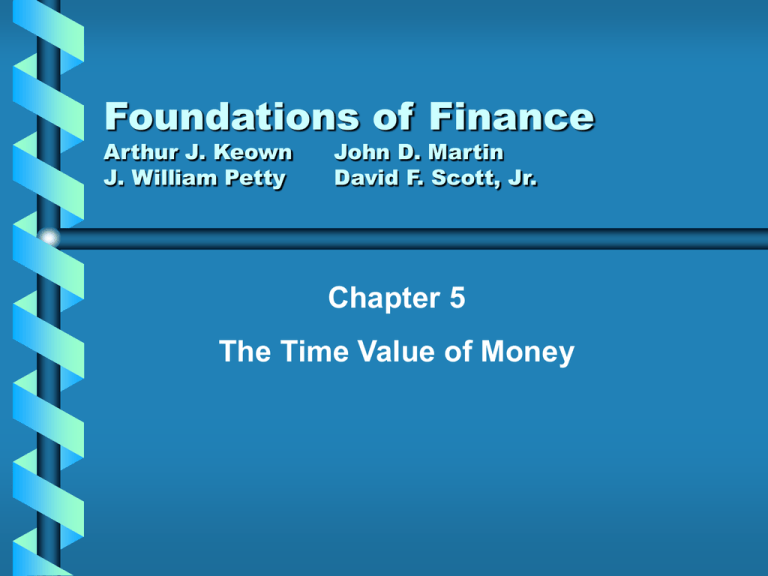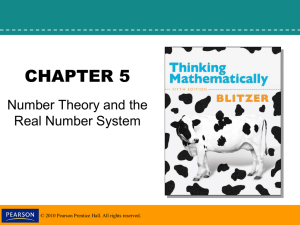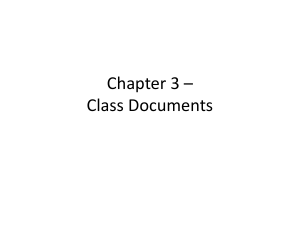
Foundations of Finance
Arthur J. Keown
J. William Petty
John D. Martin
David F. Scott, Jr.
Chapter 5
The Time Value of Money
Chapter 5
The Time Value of Money
Learning Objectives
Explain the mechanics of
compounding, which is how money
grows over a time when it is
invested.
Be able to move money through time
using time value of money tables,
financial calculators, and
spreadsheets.
Discuss the relationship between
compounding and bringing money
back to present.
5-2
Foundations of Finance
Pearson Prentice Hall
Chapter 5
The Time Value of Money
Learning Objectives
Define an ordinary annuity and
calculate its compound or future
value.
Differentiate between an ordinary
annuity and an annuity due and
determine the future and present
value of an annuity due.
Determine the future or present
value of a sum when there are
nonannual compounding periods.
5-3
Foundations of Finance
Pearson Prentice Hall
Chapter 5
The Time Value of Money
Learning Objectives
• Determine the present value of an
uneven stream of payments
• Determine the present value of a
perpetuity.
• Explain how the international setting
complicates the time value of money.
5-4
Foundations of Finance
Pearson Prentice Hall
Chapter 5
The Time Value of Money
Principles Used in this
Chapter
• Principle 2: The Time Value of
Money – A Dollar Received Today
Is Worth More Than a Dollar
Received in The Future.
5-5
Foundations of Finance
Pearson Prentice Hall
Chapter 5
The Time Value of Money
Simple Interest
Interest is earned on principal
$100 invested at 6% per year
1st year
interest is $6.00
2nd year
interest is $6.00
3rd year
interest is $6.00
Total interest earned: $18.00
5-6
Foundations of Finance
Pearson Prentice Hall
Chapter 5
The Time Value of Money
Compound Interest
• When interest paid on an
investment during the first
period is added to the
principal; then, during the
second period, interest is
earned on the new sum.
5-7
Foundations of Finance
Pearson Prentice Hall
Chapter 5
The Time Value of Money
Compound Interest
Interest is earned on previously earned
interest
$100 invested at 6% with annual
compounding
1st year interest is $6.00 Principal is $106.00
2nd year interest is $6.36 Principal is $112.36
3rd year interest is $6.74 Principal is $119.11
Total interest earned:
$19.11
5-8
Foundations of Finance
Pearson Prentice Hall
Chapter 5
The Time Value of Money
Future Value
- The amount a sum will grow in
a certain number of years when
compounded at a specific rate.
5-9
Foundations of Finance
Pearson Prentice Hall
Chapter 5
The Time Value of Money
Future Value
FV1 = PV (1 + i)
Where FV1 = the future of the investment at
the end of one year
i= the annual interest (or discount)
rate
PV = the present value, or original
amount invested at the beginning
of the first year
5 - 10
Foundations of Finance
Pearson Prentice Hall
Chapter 5
The Time Value of Money
Future Value
What will an investment be worth
in 2 years?
$100 invested at 6%
FV2= PV(1+i)2 = $100 (1+.06)2
$100 (1.06)2 = $112.36
5 - 11
Foundations of Finance
Pearson Prentice Hall
Chapter 5
The Time Value of Money
Future Value
• Future Value can be increased
by:
• Increasing number of years of
compounding
• Increasing the interest or
discount rate
5 - 12
Foundations of Finance
Pearson Prentice Hall
Chapter 5
The Time Value of Money
Future Value Using Tables
FVn = PV (FVIFi,n)
Where FVn = the future of the investment at
the end of n year
PV = the present value, or original
amount invested at the beginning
of the first year
FVIF = Future value interest factor or
the compound sum of $1
i= the interest rate
n= number of compounding periods
5 - 13
Foundations of Finance
Pearson Prentice Hall
Chapter 5
The Time Value of Money
Future Value
What is the future value of $500
invested at 8% for 7 years? (Assume
annual compounding)
Using the tables, look at 8% column, 7
time periods. What is the factor?
FVn= PV (FVIF8%,7yr)
= $500 (1.714)
= $857
5 - 14
Foundations of Finance
Pearson Prentice Hall
Chapter 5
The Time Value of Money
Future Value Using Calculators
Using any four inputs you will find the 5th.
Set to P/YR = 1 and END mode.
INPUTS
N
10
PV
-100
PMT
0
FV
179.10
5 - 15
OUTPUT
I/YR
6
Foundations of Finance
Pearson Prentice Hall
Chapter 5
The Time Value of Money
Future Value Using Spreadsheets
Spreadsheets and the Time Value of Money
If we invest $500 in a bank where it will earn 8 percent compounded
annually, how much will it be worth at the end of 7 years?
rate (I) =
number of periods (n) =
payment (PMT) =
present value (PV) =
type (0=at end of period) =
Future value =
8%
7
0
$500
0
$856.91
Excel formula: FV = (rate, number of periods, payment, present value, type)
Entered in cell d13: = FV(d7,d8,d9,-d10,d11)
Notice that present value ($500) took a negative value
5 - 16
Foundations of Finance
Pearson Prentice Hall
Chapter 5
The Time Value of Money
Present Value
The current value of a future payment
PV = FVn {1/(1+i)n}
Where FVn = the future of the investment at
the end of n years
n= number of years until payment is
received
i= the interest rate
PV = the present value of the future sum
of money
5 - 17
Foundations of Finance
Pearson Prentice Hall
Chapter 5
The Time Value of Money
Present Value
What will be the present value of $500
to be received 10 years from today if
the discount rate is 6%?
PV = $500 {1/(1+.06)10}
= $500 (1/1.791)
= $500 (.558)
= $279
5 - 18
Foundations of Finance
Pearson Prentice Hall
Chapter 5
The Time Value of Money
Present Value Using Tables
PVn = FV (PVIFi,n)
Where PVn = the present value of a future sum of
money
FV = the future value of an investment at
the end of an investment period
PVIF = Present Value interest factor of $1
i= the interest rate
n= number of compounding periods
5 - 19
Foundations of Finance
Pearson Prentice Hall
Chapter 5
The Time Value of Money
Present Value
What is the present value of $100
to be received in 10 years if the
discount rate is 6%?
PVn = FV (PVIF6%,10yrs.)
= $100 (.558)
= $55.80
5 - 20
Foundations of Finance
Pearson Prentice Hall
Chapter 5
The Time Value of Money
Present Value Using Calculators
Using any four inputs you will find the 5th.
Set to P/YR = 1 and END mode.
INPUTS
N
10
I/YR
6
PMT
0
FV
100.00
5 - 21
OUTPUT
PV
-55.84
Foundations of Finance
Pearson Prentice Hall
Chapter 5
The Time Value of Money
Annuity
• Series of equal dollar payments
for a specified number of years.
• Ordinary annuity payments
occur at the end of each period
5 - 22
Foundations of Finance
Pearson Prentice Hall
Chapter 5
The Time Value of Money
Compound Annuity
• Depositing or investing an equal
sum of money at the end of
each year for a certain number
of years and allowing it to grow.
5 - 23
Foundations of Finance
Pearson Prentice Hall
Chapter 5
The Time Value of Money
Compound Annuity
FV5 = $500 (1+.06)4 + $500 (1+.06)3
+$500(1+.06)2 + $500 (1+.06) + $500
= $500 (1.262) + $500 (1.191) +
$500 (1.124) + $500 (1.090) +
$500
= $631.00 + $595.50 + $562.00 +
$530.00 + $500
= $2,818.50
5 - 24
Foundations of Finance
Pearson Prentice Hall
Chapter 5
The Time Value of Money
Illustration of a 5yr $500 Annuity
Compounded at 6%
0
1
2
3
4
5
500
500
500
500
500
6%
5 - 25
Foundations of Finance
Pearson Prentice Hall
Chapter 5
The Time Value of Money
Future Value of an Annuity
FV = PMT {(FVIFi,n-1)/ i }
Where FV n= the future of an annuity at
the end of the nth years
FVIFi,n= future-value interest factor or sum of
annuity of $1 for n years
PMT= the annuity payment deposited or
received at the end of each year
i= the annual interest (or discount) rate
n = the number of years for which the
annuity will last
5 - 26
Foundations of Finance
Pearson Prentice Hall
Chapter 5
The Time Value of Money
Compounding Annuity
What will $500 deposited in the bank
every year for 5 years at 10% be
worth?
FV = PMT {(FVIFi,n-1)/ i }
Simplified this equation is:
FV5 = PMT(FVIFAi,n)
= $500(5.637)
= $2,818.50
5 - 27
Foundations of Finance
Pearson Prentice Hall
Chapter 5
The Time Value of Money
Future Value of an Annuity
Using Calculators
Using any four inputs you will find the 5th.
Set to P/YR = 1 and END mode.
INPUTS
N
5
PV
0
I/YR
6
PMT
500
5 - 28
OUTPUT
FV
-2,818.55
Foundations of Finance
Pearson Prentice Hall
Chapter 5
The Time Value of Money
Present Value of an Annuity
• Pensions, insurance obligations,
and interest received from
bonds are all annuities. These
items all have a present value.
• Calculate the present value of
an annuity using the present
value of annuity table.
5 - 29
Foundations of Finance
Pearson Prentice Hall
Chapter 5
The Time Value of Money
Present Value of an Annuity
Calculate the present value of a $500
annuity received at the end of the
year annually for five years when the
discount rate is 6%.
PV = PMT(PVIFAi,n)
= $500(4.212)
= $2,106
5 - 30
Foundations of Finance
Pearson Prentice Hall
Chapter 5
The Time Value of Money
Annuities Due
• Ordinary annuities in which all
payments have been shifted
forward by one time period.
5 - 31
Foundations of Finance
Pearson Prentice Hall
Chapter 5
The Time Value of Money
Amortized Loans
• Loans paid off in equal
installments over time
– Typically Home Mortgages
– Auto Loans
5 - 32
Foundations of Finance
Pearson Prentice Hall
Chapter 5
The Time Value of Money
Payments and Annuities
If you want to finance a new
machinery with a purchase
price of $6,000 at an interest
rate of 15% over 4 years, what
will your payments be?
5 - 33
Foundations of Finance
Pearson Prentice Hall
Chapter 5
The Time Value of Money
Future Value Using Calculators
Using any four inputs you will find the 5th.
Set to P/YR = 1 and END mode.
INPUTS
N
4
PV
6,000
I/YR
15
FV
0
5 - 34
OUTPUT
PMT
-2,101.59
Foundations of Finance
Pearson Prentice Hall
Chapter 5
The Time Value of Money
Amortization of a Loan
• Reducing the balance of a loan via
annuity payments is called
amortizing.
• A typical amortization schedule
looks at payment, interest, principal
payment and balance.
5 - 35
Foundations of Finance
Pearson Prentice Hall
Chapter 5
The Time Value of Money
Amortization Schedule
Yr.
Annuity
Interest Principal
1
$2,101.58
$900.00 $1,201.58 $4,798.42
2
$2,101.58
719.76
1,381.82
3,416.60
3
$2,101.58
512.49
1,589.09
1,827.51
4
$2,101.58
274.07
1,827.51
5 - 36
Foundations of Finance
Balance
Pearson Prentice Hall
Chapter 5
The Time Value of Money
Compounding Interest with
Non-annual periods
If using the tables, divide the percentage by
the number of compounding periods in a
year, and multiply the time periods by the
number of compounding periods in a year.
Example:
8% a year, with semiannual compounding for
5 years.
8% / 2 = 4% column on the tables
N = 5 years, with semiannual compounding
or 10
Use 10 for number of periods, 4% each
5 - 37
Foundations of Finance
Pearson Prentice Hall
Chapter 5
The Time Value of Money
Perpetuity
• An annuity that continues forever is
called perpetuity
• The present value of a perpetuity is
PV = PP/i
PV = present value of the perpetuity
PP = constant dollar amount
provided by the of perpetuity
i = annuity interest (or discount
rate)
5 - 38
Foundations of Finance
Pearson Prentice Hall
Chapter 5
The Time Value of Money
The Multinational Firm
• Principle 1- The Risk Return Tradeoff – We
Won’t Take on Additional Risk Unless We
Expect to Be Compensated with Additional
Return
• The discount rate is reflected in the rate of
inflation.
• Inflation rate outside US difficult to predict
• Inflation rate in Argentina in 1989 was
4,924%, in 1990 dropped to 1,344%, and in
1991 it was only 84%.
5 - 39
Foundations of Finance
Pearson Prentice Hall







